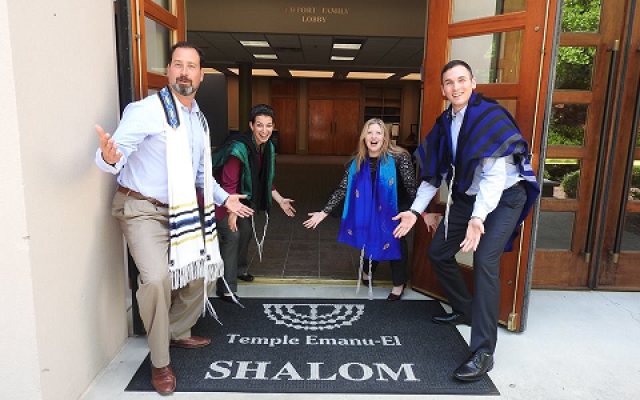Resilience Key to Temple Emanu-El’s History
Looking back at the last 40 years of the community at TE.

In the mid-1970s, Parkaire Field stopped accepting small aircraft and the Chattahoochee Nature Center started accepting naturalists. Marietta was steadily producing subdivisions full of red brick colonials, swimming pools, clubhouses, HOAs and block parties.
Families were leaving Jewish neighborhoods like Morningside and Toco Hills and areas like Midtown and Buford Highway, heading to the suburbs. As the summer came to a close in 1978 and High Holy Days approached, 10 families on the north side longed for a Reform Jewish community.
The Temple was geographically undesirable; Temple Sinai had a wait list for new members.
On Sept. 15, 1978, Don and June Restler invited a small group to brainstorm. Just 10 days later the members of The Reform Temple of Roswell held its first Shabbat service in the Restlers’ backyard.
In a flash, Rabbi Donald Tam – with the help of the Union of American Hebrew Congregations – installed a steering committee, charter, constitution and bylaws for newly-branded Temple Emanu-El.
New Jersey transplants Arthur and Carol Katz had moved to the suburbs in search of a more attractive place to raise a family, and to escape the Northeast rat race.
“Word had it there was new synagogue starting up in our general area. We checked it out and said, ‘Let’s do this.’ It’s a story that repeated itself with many members who were joining at that time. For a while, Emanu-El was the fastest growing synagogue in the United States,” Arthur Katz said.

From Friday night services held at the Dunwoody Decatur Federal Springs Bank to religious school held in members’ homes, Temple Emanu-El grew into a community known for roaming Torahs. The congregation’s first permanent Torah came from Temple Sinai, where Temple Emanu-El held religious school classes for years.
On Sept. 22, 1980, Temple Emanu-El purchased 1580 Spalding Drive in Sandy Springs. The lot was under consideration by Fulton County Board of Education to house an elementary school, until the idea was rejected.
Change was palpable: Steve Zisser was elected board president, Tam was renewed for three years, Warren Epstein was named architect, and Arthur Blank was building construction chair.
The groundbreaking ceremony took place on Feb. 13, 1983. Phillip Ratner, an internationally known biblical artist, was commissioned to design and install the stained glass windows, ark doors, ner tamid (eternal light) and Temple Emanu-El’s distinctive menorah symbol. Still today, members consider the sanctuary the pinnacle of the structure.
“The sanctuary is gorgeous,” said Rabbi Spike Anderson.
The sanctuary is where Temple Emanu-El comes to life. Rabbi Max Miller (who grew up at the synagogue), Rabbi Rachael Klein Miller and Cantor Lauren Adesnik welcome in Shabbat, longtime member Ann Rollins sits down to play the grand piano, and parents shuffle in the door with young children by their sides.
“Friday night services bring high energy, joy and lots of singing and music with a meditative feel. The sanctuary is packed. We are a proud Reform Zionist congregation,” Anderson said.

The congregation shines on Simchat Torah, a spirited holiday to which Anderson brought a heightened sense of participation. After a children’s consecration, an Afro-Klezmer band brings the beat as members hang out, dance and read from the Torah as the scroll is unrolled around the room.
“It is the resilience of our synagogue – whether through changes in clergy, the recession, a drop or an increase in membership – that strikes me. The resilience of members, clergy and staff is what keeps the congregation going,” said William Berger, temple historian.
Members since the early years, Berger and his wife, Rhea, watched Temple Emanu-El survive the formation of nearby synagogues, including Congregation Dor Tamid, Temple Beth Tikvah and Temple Kehillat Chaim.
Berger is a former program chair of the Jewish Book Festival and passionate about book collecting. In 2008, Berger wrote a retrospective for Temple Emanu-El’s 30th anniversary that details the history year by year.
“This congregation has invested in programming and people and it shows,” Anderson said. “If you have an involved, kind, lay leadership everything goes better. Here we have a huge percentage relative to other synagogues: one-third of adult members are involved on boards, committees, thought groups …It’s a volunteer-driven congregation. Many people involved in early years are still active. They’ve watched for two generations the ebb and flow. We are in a good place.”



comments